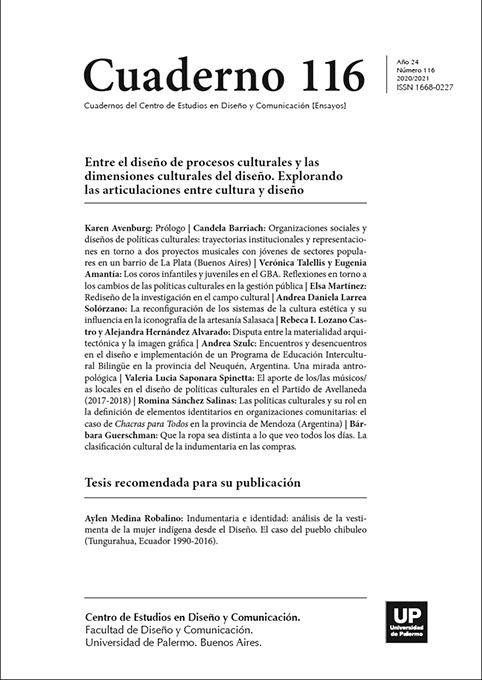Disputa entre la materialidad arquitectónica y la imagen gráfica
Abstract
The following article derived from the findings obtained from the field work carried out in the Thesis of the Doctorate of Design of the University of Palermo by one of the authors, Dr. Rebeca Lozano (2018). In relation to this, data obtained on the perception of the architect and graphic designer are presented in their joint work area for the commercial facades in the city of Tampico, Mexico. It was thoughtful to think of the work carried out by professionals of these two disciplines in the approach and architectural execution, but also in the visual result of communication between architecture and graphic design. Commercial buildings were considered from their design planning, construction, structural functionality, to internal signage. However, that did not happen when it came to linking with the identifying-corporate graphic design on the commercial facade. Particular case studies were identified, with disengagement in their visual-communicative production as an important factor in the process of commercial architectural planning-construction. The conclusions obtained represent a reference framework for guiding the inclusive planninglinkage between the architecture and commercial graphic design exposed on public roads, which can guide the identification and social significance of the culture of Tampico.
References
Alabarces, P. (2002). Culturas de las clases populares, una vez más: la leyenda continúa. Nueve proposiciones en torno a lo popular. VI Jornadas Nacionales de Investigadores en Comunicación. Córdoba, Argentina.
Bourdieu, P. (2012). La distinción, criterio y bases sociales del gusto, (pp. 56-169; pp. 257- 296). Buenos Aires: Editorial Taurus.
Costa, J. (1987). Señalética. Enciclopedia de Diseño (pp. 23-107, 122-137). Barcelona, España: CEAC.
Costa, J. (2007). Señalética Corporativa, (pp. 36-40). España: Autor editor.
Chaves, N. (2003). La imagen corporativa, (pp. 39-43). Barcelona, España: Editorial Gustavo Gili.
Dijk, V. (1996). Las estructuras y funciones del discurso, una introducción disciplinaria a la lingüística del texto y a los estudios del discurso. México: Editorial Siglo XXI.
Fernández, J. L. (1995). Estilo discursivo y planeamiento comunicacional. Oficios Terrestres, 1, 1-12. La Plata: Fac. de Periodismo y Comunicación Social, UNLP.
García Canclini, N. (2005). Culturas Híbridas, Estrategias para entrar y salir de la modernidad, (pp. 259-288). México: Editorial Grijalbo, S.A. de C.V.
García Santibañez, F. y Kasis, A. (2009). Problemas del Diseño Gráfico en la Arquitectura. Revista H+D Hábitat más Diseño, 2(1), 66-83. Recuperado de https://ninive.uaslp.mx/xmlui/bitstream/handle/i/2740/revista_H+D_2.pdf?sequence=2#page=67
Grimson, A. (2010). Culture and Identity: two different notions. Social Identities, 16 (1), 63-79.
Grimson, A. (2011). Los límites de la cultura, crítica de las teorías de la identidad. Argentina: Editorial Siglo XXI.
Lozano Castro, R. I. (2018). Gráficas Identificativas en fachadas de microempresas de Tampico, Transformaciones culturales y comunicacionales por impacto comercial, 1994 a 2013. Universidad de Palermo, Buenos Aires, Argentina. Lynch, K. (2015). La imagen de la ciudad, (p. 11). España: Gustavo Gili.
Venturi, R. (2011). Aprendiendo de las Vegas. Barcelona, (pp. 77-79). España: Editorial Gustavo Gili.
Villagrán García, J. (1980). Teoría de la Arquitectura, (pp. 29-53). Cuadernos de arquitectura y conservación del patrimonio artístico. Recuperado de https://es.scribd.com/document/154039567/Teoria-de-La-Arquitectura-Villagran
Williams, R. (1980). Teoría cultural. Marxismo y Literatura, (pp. 294). Barcelona, España: Península. Entrevistas A. Espuna (comunicación personal a distancia, 13 de febrero, 2017). J. Torres (comunicación personal, 14 de noviembre de 2018).
Los autores/as que publiquen en esta revista ceden los derechos de autor y de publicación a "Cuadernos del Centro de Estudios de Diseño y Comunicación", Aceptando el registro de su trabajo bajo una licencia de atribución de Creative Commons, que permite a terceros utilizar lo publicado siempre que de el crédito pertinente a los autores y a esta revista.


